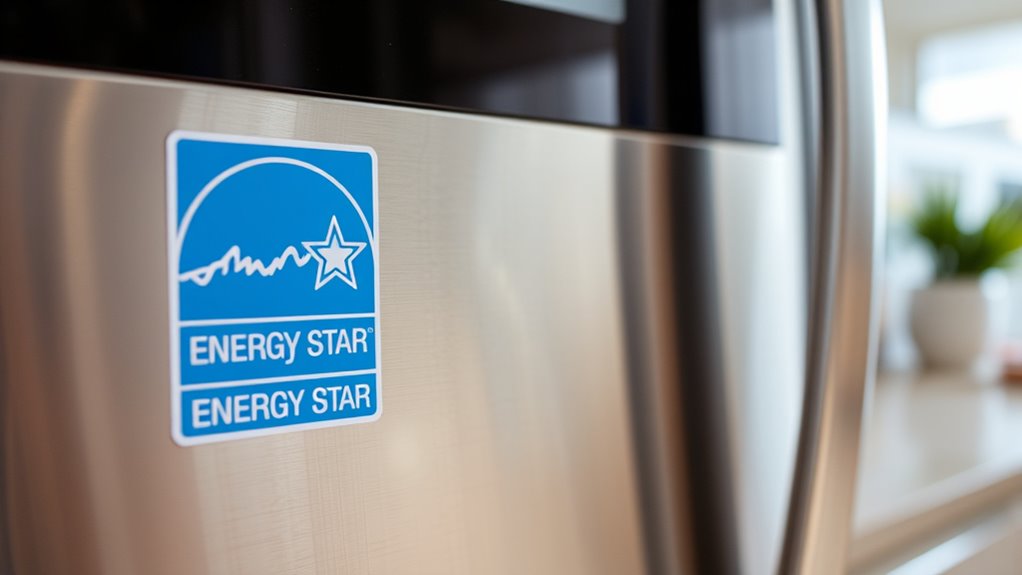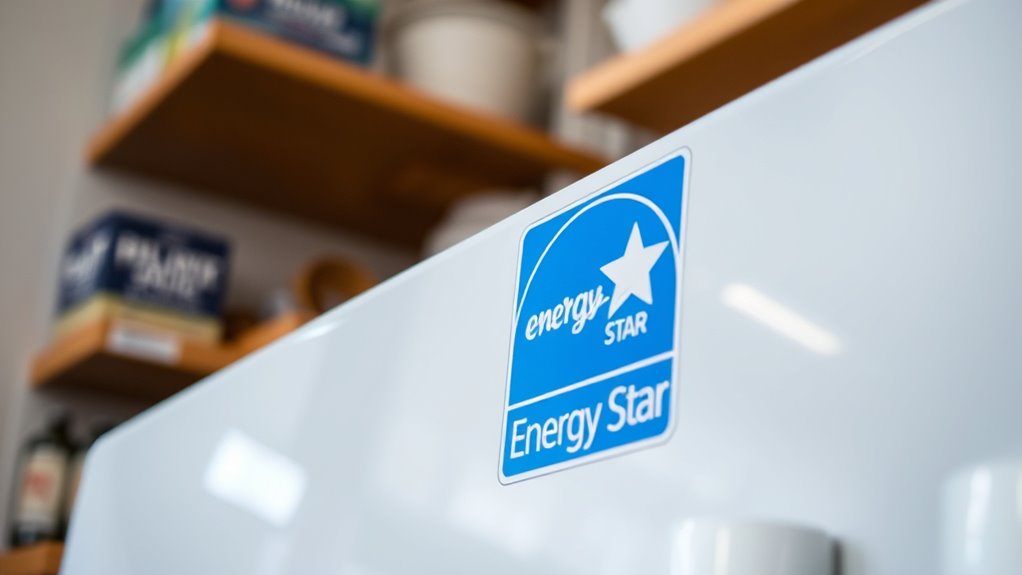Energy Star labels help you identify appliances that meet strict energy efficiency standards, making it easier to choose eco-friendly and cost-saving options. They indicate products that use less electricity and water, often performing better than standard models. These labels not only help reduce your utility bills but also lower your household’s carbon footprint. Understanding how they work can empower you to make smarter, more sustainable choices—continue to explore how these labels can benefit you and the environment.
Key Takeaways
- Energy Star labels indicate appliances that meet strict energy efficiency standards.
- They provide a quick visual cue for environmentally friendly and cost-saving products.
- Appliances undergo rigorous testing to qualify for Energy Star certification.
- The label helps consumers reduce energy use, utility bills, and carbon footprint.
- Energy Star focuses on efficiency, complementing renewable energy certifications for sustainability.

Have you ever wondered what those Energy Star labels on appliances really signify? It’s a good question, especially since these labels are everywhere—from refrigerators to washing machines. The Energy Star program is a government-backed initiative that helps consumers identify products that meet strict standards for energy efficiency. When you see that label, it’s a quick way to gauge whether an appliance is designed to save energy and reduce your utility bills. But what does this label actually represent, and how does it relate to renewable certifications or appliance efficiency?
Energy Star certification isn’t just about cutting costs; it’s also about promoting environmentally friendly choices. Appliances with this label have undergone rigorous testing to ensure they meet high standards for energy performance. They’re typically more efficient than standard models, which means they use less electricity, water, or both, depending on the appliance. This efficiency not only benefits your wallet but also minimizes your carbon footprint. The label itself acts as a trustworthy marker indicating that the product has achieved a certain level of appliance efficiency that surpasses federal minimum standards.
Energy Star labels indicate appliances meet high standards for energy efficiency and environmental responsibility.
Renewable certifications, on the other hand, focus more on the sustainability of the energy source used, rather than just the efficiency of the appliance itself. While Energy Star primarily emphasizes appliance efficiency regardless of the power source, some products might also carry renewable certifications, such as for solar or wind-powered systems. These certifications assure you that the energy used is sourced from renewable resources, further reducing environmental impact. When choosing appliances, looking for both energy efficiency and renewable certifications can help you make more eco-conscious decisions, aligning your household with renewable energy goals.
Understanding these distinctions helps you see that Energy Star labels are a practical tool for reducing energy consumption and supporting sustainability. They encourage manufacturers to innovate and improve appliance efficiency, which ultimately helps you save money and lessen environmental harm. When shopping, focus on appliances with the Energy Star label, but also consider accompanying renewable certifications if you want to maximize your environmental impact. This way, you’re not just buying a more efficient appliance—you’re making a conscious choice to support renewable energy sources and a cleaner planet.
Additionally, fostering awareness of creative practice can inspire innovative solutions towards energy efficiency and sustainability in daily life.
Frequently Asked Questions
How Do Energy Star Labels Impact Product Resale Value?
Energy Star labels can boost your product’s resale value by demonstrating efficiency and sustainability, appealing to eco-conscious buyers. You’ll find that consumer perception shifts positively when products have this certification, making them more attractive and potentially increasing demand. This label signals quality and low energy costs, so you can expect higher resale prices. Overall, Energy Star labels help you sell faster and at better prices by aligning with buyers’ preferences for energy-efficient options.
Are All Energy Star-Rated Products Equally Energy-Efficient?
You might think all Energy Star-rated products are equally energy-efficient, but that’s not true—some are like shining stars in a night sky, while others are just twinkling. Not every product certification guarantees maximum efficiency; label accuracy can vary. Always check the specific ENERGY STAR certification details to make sure you’re getting the most energy-efficient option. Don’t assume all labels are perfect—verify to make smarter, eco-friendly choices.
Can Energy Star Labels Be Faked or Misused?
You might wonder if energy star labels can be faked or misused. While the labels are designed to guarantee authenticity, some products may attempt label misuse prevention by falsely claiming certification. To avoid this, always verify the label’s authenticity through official sources or retailer websites. Being cautious helps you make informed decisions and supports genuine energy-efficient products, preventing deception and ensuring your purchase truly meets energy-saving standards.
Do Energy Star Labels Apply Worldwide or Only in Specific Countries?
Imagine a badge of trust that spans continents—Energy Star labels do just that. They apply mainly in the U.S. and Canada, but also enjoy international recognition. These labels rely on rigorous certification processes, ensuring products meet strict energy efficiency standards. While primarily used in North America, other countries recognize and adopt similar programs, making Energy Star a symbol of global commitment to energy conservation.
How Often Are Energy Star Standards Updated?
Energy Star standards are updated annually to keep pace with advancements in renewable energy and appliance standards. This means you benefit from improved energy efficiency and environmental benefits over time. By checking for the latest updates, you guarantee your appliances meet current regulations, helping reduce energy consumption and your carbon footprint. Staying informed about these updates also ensures you choose products that align with the most recent sustainability goals.
Conclusion
Now that you understand what Energy Star labels mean, you’re ready to make smarter choices. But here’s the question — will you notice the real savings and benefits once you start paying attention? Keep an eye out for these labels on your next purchase, because the difference they make might surprise you. The power to save energy, cut costs, and help the environment is in your hands—are you ready to take that step?










